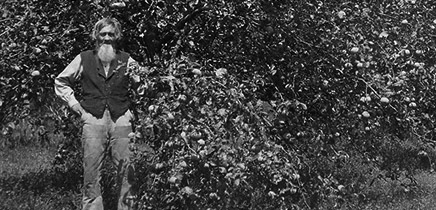In the early days of Carver County, river travel was the best way to get goods, supplies, and new immigrants to Carver County. The City of Carver had a long history as a river town, with many steamboats running up and down the river from its docks. None of these was more well-known or respected than the steamboat “Antelope”.
The Antelope was built by George and James Houghton, though captained by George Houghton. George Houghton was born January 28, 1828 in Brandon, Vermont, to Eli and Deborah (Dwinel) Houghton. James Houghton was born seven years earlier in 1821. The brothers immigrated to Minnesota in 1848 with their parents, who settled in Wright County, near Monticello. George Houghton had settled in Chaska by 1855.
The Antelope was Captain Houghton’s first endeavor into the steamboat trade, in operation between 1857-1863. The Antelope’s 37-ton capacity was designed with a shallow hull to be able to run at any water level. In her first season in 1857, this small steamboat made 105 round-trip run. It was the first steamer to provide regularly scheduled round trip service between Carver, Chaska and St. Paul. Rates for this service were $1.25, which was less than cost for passage by stagecoach. Captain Houghton’s boat was popular for the very well-behaved crew. Stoughton allowed no brawls, no drunkenness, no obscene or blasphemous language, and no improper conduct by any crew or passenger.
In her first season, the Antelope made 105 runs, with a final trip on November 14th, 1857. Just a few years later, she proved her worth and design during the unusually dry 1860 season. While other larger steamers had hulls too low or were trapped in shallows and sandbars, the Antelope kept running smoothly. Captain Houghton and his crew were the busiest steamer crew that year, making over 80% of trips to St. Paul on the Minnesota River. Of the 250 steamboat arrivals from the Minnesota River to St. Paul that year, 198 of them were made by the Antelope.
Newspaper accounts of the time praise the Antelope and her captain for always arriving on time, safe passage, and the well-behaved crew. The steamer was known to many as a “Carver County Institution.” The Antelope had a few troubles though. During the Civil War and U.S. Dakota War, the steamer hauled soldiers and supplies. On one such run, or so the story goes, passengers and crew witnessed one of the final battles fought between Dakota and Ojibwe tribes. On October 19, 1862, panicked civilians were fleeing from fear of attack by American Indians. In the hysteria, they commandeered the Antelope to try to flee.
After his success with the Antelope, Captain George Houghton, often working closely with his brother James, added to his fleet. The first to be added in 1862 were the steamboat Clara Hine, and the steamers Ariel and Albany. Each made trips twice weekly. When the Antelope aged out of service, her steam whistle was installed on the Ariel which had taken over the same route. In 1865, Houghton added the 125-foot, 56 passenger sidewheel steamboat, the Mollie Mohler. It was named for his first wife who had passed away sometime in the 1850s. In 1867, the Mollie Mohler was so busy it made over half of the 161 steamboat stops at Mankato. On May 14, 1870, the steamboat was badly scorched as it was docked alongside the War Eagle. When that steamboat exploded the Mollie Mohler was barely able to build up enough steam to move out of the way.
In 1870, Houghton branched out onto the Upper Mississippi with the Pokégama. This steamboat regularly made 2 ½ days 195 mile trips up the Mississippi from Aitkin to Grand Rapids and from Crow Wing to Pokegama Falls. It was destroyed by fire while in dry-dock on November 12, 1877.
George and his third wife Lydia retired to Minneapolis in 1883, selling their home at 120 Third Street East in Carver. George Houghton died in his home on November 7, 1902 from complications of a previous fall. He and his wife are both buried in Lakewood Cemetery in Minneapolis.
George Houghton and his steamboat Antelope are still remembered in Carver County. As one of the most reliable, timely, safe, and respectable steamboats, the Antelope will go down in steamboat history.
“Carver County, Its Towns, and Some of the Early Settlers.” Weekly Valley Herald, February 27, 1879.
Hartley, Lucie K. The Carver Story. 2nd ed. Carver, MN: printed by author, 1993.
Heritage Preservation Commission of the City of Carver. “Carver Historic District, Dakota Uprising Sesquicentennial Update, 1862-2012.” Walking tour, 2012. http://www.cityofcarver.com/carver-history/
Hughes, Thomas. “History of Steamboating on the Minnesota River.” Collections of the Minnesota Historical Society, 10 no. 1 (1905): 134-158. https://archive.org/stream/historyofsteambo00hughrich/historyofsteambo00hughrich_djvu.txt
“Obituary.” Weekly Valley Herald, February 2, 1872.
Petersen, William J. “The Early History of Steamboating on the Minnesota River.” Minnesota History, 11 no. 2 (June 1930): 123-144. http://collections.mnhs.org/MNHistoryMagazine/articles/11/v11i02p123-144.pdf
“River Business.” Weekly Valley Herald, May 16, 1863.
“River Business.” Weekly Valley Herald, May 30, 1863.


